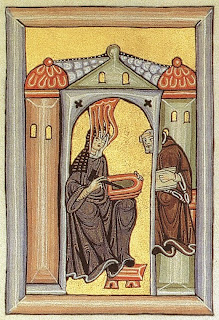 Who the heck was Hildegard of Bingen? Who the heck is Simon?
Who the heck was Hildegard of Bingen? Who the heck is Simon?Only the guys present at the meeting know Simon’s real name, and I’d like to keep it that way. But I’ll offer you some other data that Simon offered this morning, quite openly. Simon was walking around Paris in the middle of the night about twenty years ago when he saw a doorway. He entered the doorway and found a Perpetual Adoration chapel and a monastery next door. Simon said he has returned to Paris “at least a dozen times” since then, for the sole purpose of returning to that chapel. After the meeting I asked Simon what he was doing wandering around Paris in the middle of the night. “Drunk?” I asked. “Drugged? Psychotic?” He only nodded, as if to say, all of the above.
Who better, then, to hem and haw his way through a heart-felt but wildly improvisational presentation on a 12th-century saint (or blessed) (Simon wasn't really clear) whose Wikipedia entry includes the following bullet points: Christian mystic, German Benedictine abbess, author, counselor, linguist, naturalist, scientist, philosopher, physician, herbalist, poet, channeler, visionary, composer, and polymath. I had already encountered Hildegard through her remarkable music. (I’m listening to the CD “Canticles of Ecstasy” right now and would happily listen to her an hour a day for the duration.) The bullet point that had previously grabbed my attention, mentioned later in the Wiki entry: Hildegard is the first composer, male or female, of whom we have a contemporaneous biography.
I’ve been corresponding with my new friend and blogging pal Frank about the subject of war and the Church’s teaching on war. Frank, a retired US Marine with all the military bona fides you could want, pointed me in the direction of Bernard of Clairvaux, because Bernard was both the founder of the Cistercians (contemplative, pacifist) and a leading proponent of the Second Crusade (active, pugnacious). Reading about Bernard during the past 24 hours, I think I've found a model for how a Catholic might look at both pacifism and what the Catechism terms “just war.”
And who—it turns out, according to Simon—was one of Bernard of Clairvaux’s 12th-century pals? None other than our Hildegard of Bingen!
This is what I love about Catholicism. You meet the strangest people, from those in your parish (Simon) to those in the martyrology (Hildegard). You find these strange people conversing with one another, studying each other, mutually fascinated and fascinating—and constantly connecting with other equally strange and fascinating people. There are so many of these people to be met—some far stranger than others, but all of them fixed on the same teaching, the same Gospel, within the same Universal Catholic Church—that you are forced to one of two conclusions, and there is no other.
Either (a) the whole world is mad and wandering around in a psychotic daze in Paris in the middle of the night or (b) Jesus Christ is Lord.
